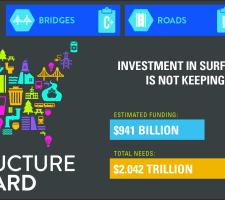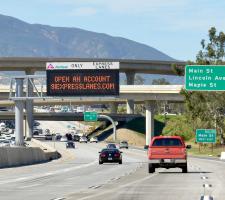
Pat Jones may have been executive director and CEO of the International Bridge, Tunnel and Turnpike Association (
“As an industry, we are constantly looking at the horizon to try to see what is in front of us, what we need to be concerned about and how these changes will affect our operations,” said Jones. “We’re also looking at other industries because tolling is just one piece of the wider transportation sector; we’re trying to figure out how we fit in and how we grow within this community.
“As I like to say; when you’ve seen one toll facility, you’ve seen one toll facility. They have a common business operation – financed with bonds and collecting tolls, so they all need to provide a superior service that drivers are willing to pay for. But their operations are all very different. Some will see 90% of the vehicles returning every day, others may only have 10% of their users as repeat customers. Toll operators in Florida don’t care about snow removal equipment whereas in Pennsylvania, that’s their lifeblood and for six months out of the year they are thinking ‘how do I get rid of this snow and keep the road clear and safe?
“So even now there is not a single solution that fits all tolling operations and there certainly won’t be a uniform operational model after the impact of all the changes we see coming down the line,” Jones observes.
One of the biggest challenges will be autonomous vehicles. “We approach our appreciation of what the use of these shared autonomous vehicles will look like with our current understanding of how things work. In going to the Lisbon example, there are probably things that are missing, things we can’t project which will change our assumptions or predictions of what will happen – the ‘unknown unknowns’ so to speak. While many people think they can predict the ‘end game’, the path to it will be a lot slower, more difficult and involved than they expect, so changes will be more gradual and give businesses time to adjust as things become clearer.”
One of the more immediate issues, at least on the political horizon, is road user charging (RUC), which is gaining more attention as the move to electric vehicles accelerates, and which will decimate fuel sales and with it fuel tax, one of many governments’ most lucrative funding streams. So, we asked Jones, will tolling still be needed if all vehicles are paying a fee for each mile travelled?
“Tolling and road user charging is not a ‘one or the other’ situation, the two are complementary. Take, for example, the Ohio Turnpike which runs for 241 miles across the state and was built in the 1950s and 60s and is now in a 30-year process to reconstruct the entire roadway from the foundation up. It is going to cost far more to rebuild than it did to construct originally and they have the toll revenue stream to do that.
The interstates in the US were built using money from gas taxes. “The shortfalls of funding we are seeing now in the US and elsewhere are simply a case of political weakness that prevented gas taxes from being raised in line with inflation?
“The initial proposal for the interstate network was that it should be tolled, in which case the bond holders would be looking at this saying ‘it is important we maintain this facility we have investments in’. That would have driven actions to preserve the asset and, if it was needed, an increase in the tolls. The way it played out was that the federal government paid for 90% of the construction of the interstate and each state paid the remaining 10%. Each interstate then became the responsibility of the individual state. There was never any intention for federal money to be made available to maintain those roads.
“So, either the fifty states have to find the funds to maintain the interstates or they impose on the federal government a continuing responsibility to raise gas taxes to pay for that ongoing maintenance. That hasn’t materialised.”
We asked: With the inevitability of road user charging, the dynamic pricing flexibility of new tolling systems and the capabilities of satellite tolling, would it not be advantageous to combine tolls for roads, bridges and tunnels, congestion charging and low emission zone payments into a single system?
“But what then happens when you have major infrastructure costs like the new Tappan Zee Bridge in New York? Do you increase the road user charge across the state and how will people who don’t use the bridge view that increase? If you are going to build a new infrastructure project it might be simpler to finance it with bonds and have a toll and pay it off over the next 30 years.
“In my mind, a road user charge represents basic funding in the same way as a fuel tax, and tolls present themselves as a very effective project funding and financing mechanism. But I don’t deny that the technology is available to vary the charge based on time of day or congestion or geographical location.”
So, should IBTTA members be knocking on the doors of governors to say, ‘we have the expertise in tolling and we can implement the road user charge on your behalf?’ Jones gives this a “qualified yes.”
“If you think of the Oregon example, implementing a road user charge is a long-term, patient, non-emotional, educational process. Say the words ‘road user charging’ and people don’t know what to expect. And despite everybody having a smartphone so we know where everybody is 24/7, and that if I search online for some new socks then I get bombarded with advertisements for socks, any mention of RUC and immediately privacy concerns surface. The ‘I don’t want people following me’ syndrome.
“I bet even today a lot of people who use cash to pay for road tolls do so because they want to use it anonymously and don’t want a transponder ‘tracking them’. So before implementing road user charging, there will have to be a lot of time and energy expended to build the public’s confidence that we are not doing anything untoward. In Oregon, for instance the road user charging trials had an option where, when you refuelled, the system interrogated your odometer to see how many miles you had travelled and then charged the account accordingly. No locational data, no timing information, just miles travelled.
“It needs an education process similar to when you go into an area that hasn’t had tolls, for example, the 495 Express Lanes in Northern Virginia. In that case, Transurban and Virginia DoT had a very aggressive campaign to not only educate people about the dynamic pricing of lanes but also to learn and understand their concerns and fears. There has to be a lot of listening and basic marketing to understand and address the concerns of the public.”
Would not replacing the fuel tax with the RUC levied at a rate which was equivalent to the average revenue raised, allay any financial concerns?
“You might assume that it would allay the financial concerns but consider the guy driving the Prius hybrid vehicle, who currently pays less fuel taxes than the guy in the SUV. Under a road usage charge, the Prius payment will increase while others might pay less than they do now. There will be losers as well as winners. And don’t forget that any road user charge will be subject to the same political pressures that have prevented the fuel tax being increased over the years – the very reason why we are experiencing these highways maintenance problems in the first place. The same is true in many other parts of the world and these are the problems that the tolling organisations around the world are raising money to fix in return for levying a charge to use the upgraded facility. I still believe even when - and it is when, not if - road user charging replaces fuel tax, there will still be the need for project funding that will be met by the issuing of bonds and imposition of tolls. The two will live side by side."
Interoperability and beyond
“Interoperability remains a challenge in the US. We have been working diligently at this problem since 2010 and we are getting close to the end for identifying a national tolling protocol to which all tolling agencies can migrate. The technical side is not a real problem; the bigger challenge is managing the business rules among the different agencies and integrating those back-office systems. That will also be a challenge for services such as Mobility as a Service – shouldn’t I be able to have one box or an app or whatever that may be, that allows me to use the rail or Bay Area Rapid Transit (
Business direction
“While large sections of the tolling business can be done by machines, the big advantage people provide to the business is their adaptability, their ability to listen and understand what a business’s customers need. I always return to the mantra of the business guru Peter Druker, who posed three big questions: What business are we in, who is our customer and what does our customer value? Technology does not provide the answer to those questions but it can provide data to help people answer those questions. What business are we really in? We are about providing mobility for people to get to and from work and schools and in providing freight corridors – and this is something we have to think about all the time.”









